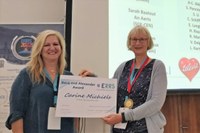Prof. Carine Michiels awarded the “Bacq and Alexander Award” from the European Radiation Research Society (ERRS)
The “Bacq and Alexander Award” for 2022 has been awarded to Carine Michiels, Professor at the Department of Biology of the UNamur and Group leader at the Laboratory of Cellular and Molecular Biology (URBC-NARILIS).
This prestigious award was established in 1996 by the ERRS. It is presented each year to an eminent European scientist in recognition of his/her research achievements in the field of radiation research.
The award ceremony took place during the annual meeting of the Society in Catania, Sicily from September 21 to 24, 2022 (www.sirr2.it/errs2022/). At this occasion, Carine Michiels gave an inspiring talk entitled “How cell biology and radiation physics met to boost radiotherapy” showing how fruitful an interdisciplinary research can be. Indeed, together with physicists Prof. Stéphane Lucas and Prof. Anne-Catherine Heuskin (LARN-NARILIS), she set up an experienced radiobiology team. Ongoing since 15 years, this collaborative work connecting biology and physics aims at enhancing the efficacy of cancer radiation therapy. Among the many research directions currently under investigation are, for example, the use of proton irradiation in combination with DNA repair inhibitors to induce synthetic lethality. NARILIS radiobiology team also developed a unique nanohybrid compound composed of gold nanoparticles coupled to targeting antibodies, being able to act as radiosensitizing agents. More recently, the group started to study the impact of different types of radiation on the immunogenicity and immunomodulatory capacity of cancer cells and other cells of the tumor microenvironment.
CONFERENCE ABSTRACT
How cell biology and radiation physics met to boost radiotherapy
Carine MICHIELS
Université de Namur, NARILIS, URBC
In close collaboration with Prof S. Lucas and A-C. Heuskin, since 15 years, studies are performed to increase the efficacy of radiotherapy using hadrons instead of photons. Indeed, the use of high energy charged particles like protons or carbon ions presents clear benefits thanks to their depth dose profile and high energy transfer. Currently, research topics include the study of the mechanisms responsible of high LET hypersensitivity and the use of proton irradiation in combination with DNA repair inhibitors to induce synthetic lethality. We also developed a unique nanohybrid compound, composed of gold nanoparticles coupled to targeting antibodies, being able to act as radiosensitizing agents for radiation therapy. We demonstrated for the first time that the enhancing effects of these nanoparticles is not due to “physical” effects but to the fact that the gold nanoparticles induced an inhibition of the antioxidant defenses within the targeted cells. Thioredoxin reductase is the main target of this effect. In addition, the responses of different types of cancer cells as well as cell of tumor microenvironment (TME) after exposure to different radiation modalities as well as to chemotherapy and targeted therapies are being investigated More recently, the group started to assess the impact of the different types of radiation on the immunogenicity and immunomodulatory capacity of cancer cells and other cells of the TME. For instance, it was determined that unlike X-rays, proton irradiations with high linear energy transfer (LET) partially reprogramed macrophages and promoted a pro-inflammatory phenotype. This discovery provides insight into mechanisms that can regulate the eradication of cancer cells by the immune system. Another project has been investigating the regulation of the expression of PD-L1 by RT. The results showed that X-ray irradiation as well as charged particle irradiation increased the gene expression and cell surface abundance of PD-L1 in multiple cancer cell lines. Using chemical inhibitors and siRNA, it was demonstrated that this mechanism involves the activation of the DNA damage response pathway and relies on the transcriptional activity of IRF1, activated upon irradiation. Furthermore, charged particle radiation increases PD-L1 abundance more strongly than X-ray and this effect seems to be potentiated by an increasing LET at doses that are equally lethal to cancer cells). These results provide further evidence that different radiation modalities at equivalent doses induce different immune-modulatory pathways. All together, these projects aim at enhancing the efficacy of radiotherapy by new developing radio-sensitization mechanisms coupled to evidence of the underlying mechanisms.
 NAmur Research Institute for LIfe Sciences
NAmur Research Institute for LIfe Sciences


